
As the COVID-19 pandemic continues to upend lives in countless ways, members of the Vanderbilt community have shown remarkable resilience in the face of the crisis. Some are on the front lines, using their expertise to combat the spread of the disease and bringing comfort to its victims, while others are making the most of the constraints of social distancing to continue the university’s mission of education and discovery. And a few even have found opportunities to inject some much-needed humor into the situation.
Here we highlight several members of the Vanderbilt community who have stepped up to meet the unprecedented challenges posed by these uncertain times.
Breathing Easier: Interdisciplinary team develops open-source ventilator design
One of the most pressing challenges for hospitals nationwide amid the COVID-19 outbreak is a dwindling number of ventilators. But an interdisciplinary team of Vanderbilt University and Vanderbilt University Medical Center faculty has devised a novel solution to help boost supply: a fabricated, open-source ventilator design.
Led on the university side by Kevin Galloway, research assistant professor of mechanical engineering, and Robert Webster, Richard A. Schroeder Professor of Mechanical Engineering, the team is currently on “version two” of the ventilator prototype and soon hopes to move into the final prototype phase before manufacturing.
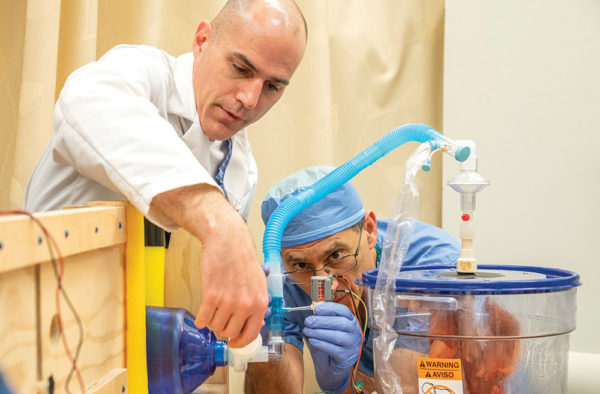
“Maker communities around the globe are stepping up to address the pressing medical challenges presented by COVID-19,” says Galloway, who is also director of making at the Wond’ry at the Innovation Pavilion. “In conversation with Bob Webster and colleagues at the Medical Center, we discussed how we can leverage our expertise to tackle this one issue that resonated most strongly for us.”
After an initial conversation with Dr. Duke Herrell, professor of urology, biomedical engineering and mechanical engineering, about the threat posed by a lack of respiratory support equipment, Webster reached out to Galloway. Galloway already had been toying with an open-source ventilator design in his home garage that would address a key difficulty in making a ventilator: replicating the precise force of the hand involved in squeezing a manual bag.
In the first prototype, Galloway wrapped nylon webbing around a bag valve mask, or “Ambu bag,” and attached it to the crank arm of a windshield wiper motor to apply the repetitive squeezing force. While the design worked, the team needed to be able to control the amount of squeeze more precisely.
Inspired by a mechanism known as a “Scotch yoke”—which converts linear motion into a circular motion, and vice versa—Galloway built his second (and latest) prototype in under three hours using the same motor, drawer glides and plywood—materials and tools that could be found almost anywhere in the world. Meanwhile, Webster and his colleagues added sensors and controls to the design to improve the safety and tune the “in-and-out” ratio to match normal breathing.
“This was the result of a lot of conversations with doctors in which it became clear that a pressure sensor with an alarm on it for too-high or too-low pressure was essential to the design,” notes Webster, who is also a professor of neurological surgery and electrical engineering, as well as an associate professor of medicine, otolaryngology and urology. “This is something we would not have known without having many Vanderbilt physicians involved in the project.”
The team is gathering feedback from ongoing ventilator tests with VUMC doctors to incorporate into a third version, which they believe will be extremely close to a design that the doctors would feel comfortable using on a patient in an emergency.
The long-term goal: “Make the design publicly available so that anyone can replicate it,” says Galloway.
—SPENCER TURNEY
Watch the ventilator design in action:
Home Away from Home: Residential college connections remain strong online
On a Wednesday night in April, when first-year residents of Gillette House on The Martha Rivers Ingram Commons would normally share a sweet treat and catch up at their traditional “Gillette Gelato” event, they still connected—but this time the room was virtual.
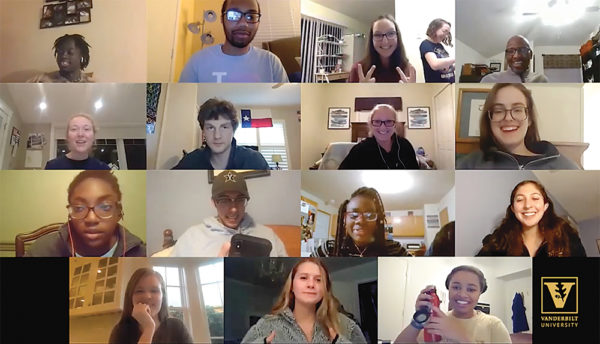
“It was clear that they all simply missed one another,” says Frank Dobson, associate dean of The Ingram Commons and faculty head of Gillette House. “These bonds have been forged since Move-In Day and strengthened on the halls, with faculty dinners, gatherings and more. It was simply wonderful to laugh together again.”
Students, resident advisers and faculty heads of house, across all of Vanderbilt’s residential colleges, created virtual spaces as the year concluded to share highs and lows of transitioning to online learning and to simply hang out.
“I was so impressed by the residents’ resilience and calm during this strange time,” says Sarah Igo, faculty head of E. Bronson Ingram College. “It was wonderful during our virtual ‘Bronson Breaks’ to confirm that students were OK and managing in creative ways in our new circumstances.
“This pause in normal life seemed to be reminding all of us how important our families, friends and communities are,” adds Igo, who is also the Andrew Jackson Professor of History and director of American Studies.
Although official house activities were suspended, some residential colleges continued online versions of their traditions. At Memorial House students shared in online “S’Memorials” as faculty head of house Dan Morgan, principal senior lecturer of Earth and environmental sciences, and his family made s’mores outdoors. The students in East House joined Zoom bake-alongs with faculty head Elizabeth Meadows, MA’06, PhD’10, senior lecturer in English. And Stambaugh House faculty head Rosevelt Noble, BS’97, PhD’03, senior lecturer in sociology and director of the Bishop Joseph Johnson Black Cultural Center, continued his weekly group workout sessions online.
“I miss my people, and I want to see them any way I can.”
“This quarantine situation could have happened 20 years ago, and we wouldn’t have had the benefit of virtual chatrooms, so I’m definitely grateful for the tools we have right now in this age of technology,” first-year student Lamar Morgan said in April. “I miss my people, and I want to see them any way I can.”
Another aspect of the pandemic that residents and faculty heads of house recognized was the historical implications of this crisis. It’s a topic that Igo and her residents discussed a lot.
“I kept telling students that this is one of the very few times in their lives that they will really feel they are living through history,” says Igo, who also has affiliate appointments in law, political science, sociology and communication of science and technology. “We are part of something that is much larger than any of us and in which, nevertheless, our particular behaviors are critical.
“I hoped we would come out of this appreciative of our fundamental interdependence and better prepared to nurture it.”
Dobson says while it was no substitute for being physically together, these new ways of connecting helped support Vanderbilt’s efforts to nurture relationships and build community. “We were all in this together whether on campus or not,” he says. “And since Vanderbilt is the students’ home away from home, the bonds were sustaining for all of us.”
—AMY WOLF
Campus Dining, Dean of Students offices continue providing support
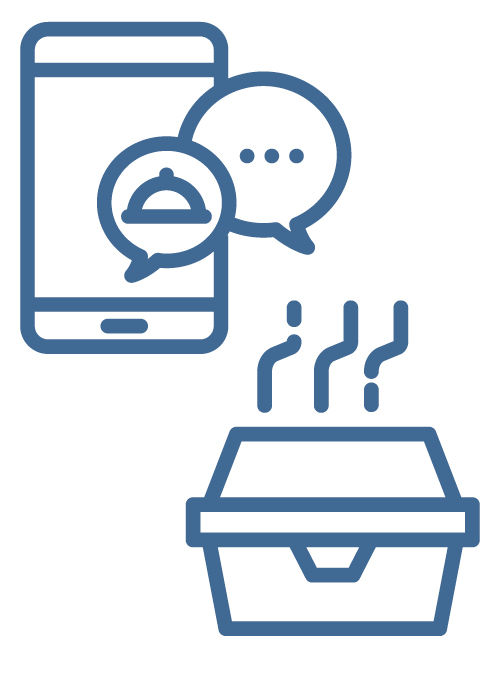 During the COVID-19 outbreak, the Vanderbilt Campus Dining team has worked around the clock to feed the students, residential faculty and support staff who, out of necessity, remain on campus by operating two dining locations—the Rand Hall and Martha Rivers Ingram Commons dining centers.
During the COVID-19 outbreak, the Vanderbilt Campus Dining team has worked around the clock to feed the students, residential faculty and support staff who, out of necessity, remain on campus by operating two dining locations—the Rand Hall and Martha Rivers Ingram Commons dining centers.
As part of its preparations, Campus Dining coordinated with key suppliers to ensure there was enough food—plus backup—to get through the pandemic. Campus Dining staff members also adopted CDC-recommended protocols, such as minimizing contact with food, enhancing cleaning procedures, and helping ensure safe meal service to all dining patrons. Some of those changes include switching completely to “to-go” orders, eliminating self-serve options, and creating tailored menus so patrons could be served quickly.
“Vanderbilt Campus Dining was able to move quickly to implement plans that we had discussed, practiced and planned for in advance. The team has really come together to make this happen,” says David ter Kuile, Campus Dining’s executive director for business services.
In addition to operating the two core dining facilities, Campus Dining partnered with the Office of the Dean of Students to develop and implement an SMS text message-based ordering system for students in quarantine and self-isolation. Students confined to their residence-hall rooms can text a unique code and order from a menu of options for breakfast, lunch and dinner. Meals are prepared by Campus Dining chefs and then delivered to student rooms.
—KATHERINE KEITH
Visual Aid: Researchers develop real-time maps of COVID-19 spread
 When the first cases of COVID-19 were diagnosed in Tennessee, Natalie Robbins, a staff researcher with the Vanderbilt Initiative for Interdisciplinary Geospatial Research (VIIGR), was curious to see where the cases were across the state—and how they would spread.
When the first cases of COVID-19 were diagnosed in Tennessee, Natalie Robbins, a staff researcher with the Vanderbilt Initiative for Interdisciplinary Geospatial Research (VIIGR), was curious to see where the cases were across the state—and how they would spread.
“I was able to find maps that reported how many cases there were per state, such as Johns Hopkins’ global coronavirus map, but there was nothing out there showing county-level data,” says Robbins, who develops informatics techniques to analyze spatial data and environmental phenomena. “I knew it would be helpful for Tennesseans to see where the cases were relative to where they lived, so after a few days, I decided I would just build that map myself.”
The Tennessee COVID-19 map Robbins developed not only shows where the positive cases are across the state—drawn from the Tennessee Department of Health—but also provides the latest information on negative test results, as well as test results for non-Tennessee residents diagnosed here. In addition, the map provides metrics for each county that policymakers may find relevant to their public health efforts, including the number of families with children, percent elderly, percent eligible for federal nutrition assistance, percent uninsured, percent insured by Medicare and more.
Steven Wernke, Joe B. Wyatt Distinguished University Professor, associate professor of anthropology, and director of VIIGR and Vanderbilt’s Spatial Analysis Research Laboratory (SARL), collaborated with Robbins on the map’s development. “Our hope here is not only that the public will be able to refer to this to stay informed, but that policymakers will use this information to identify areas of the state that may need extra support,” he says.
Inspired by Robbins’ efforts, anthropology Ph.D. student Gabriela Oré, MA’17—who normally spends her days as an archaeologist studying the Andes—decided to build a similar map for her native Peru.
“A map like this can help the public easily understand how this crisis is affecting their particular area.”
The Peru COVID-19 map provides the latest information from Peru’s Ministry of Health, which is updated daily. Not only does it include diagnostic data, but it also displays the severity of the disease in hospitalized patients, showing the rising demand for ventilator support. An accompanying chart also shows the rate of new diagnoses over time—making it possible to track the impact not only of the disease but of mitigation factors, like the implementation of social distancing orders.
“It can be difficult to comprehend the impact of something like this from a news report or a press conference,” Oré says. “A map like this can help the public easily understand how this crisis is affecting their particular area.”
Both maps have been widely shared on social media, and the Tennessee map has been used as a reference by Metro Nashville’s coronavirus task force. Both maps are available for any public health agency or task force to use.
—LIZ ENTMAN
Defending at a Distance: Physics grad student embraces ‘dissertation-at-home’ format

For graduate students nearing the end of their programs, COVID-19 created an unexpected challenge: presenting an effective and engaging dissertation defense remotely.
That was the situation facing physicist Kyle Godbey, MA’17, PhD’20, who found out the weekend before his scheduled dissertation defense that he would be doing it by teleconference.
“Everything happened quite late into my preparation for my defense,” Godbey says. “Luckily, as a computational physicist, I’m comfortable with computers—and I embraced the idea of a remote videoconference for the presentation.”
His dissertation, “Low-Energy Nuclear Reactions Using Time-Dependent Density Functional Theory,” looks at low-energy nuclear reactions and what researchers can learn from colliding nuclei.
“Kyle’s presentation showed that even under these unprecedented conditions, an excellent defense is possible,” says his adviser, Professor of Physics Sait Umar. “He delivered with a calm demeanor and presented his large body of work in a concise and pedagogical manner.”
For Godbey, preparing his defense wasn’t just a simple matter of flipping open a laptop and proceeding as one would in person. He tested his internet and audio connections the night before to ensure they would be able to handle the videoconference. He also had to consider that his material would be coming across screens as large as a television and as small as a mobile phone.
Beyond the technical matters, Godbey says certain aspects of his presentation also needed some adjustment. “I tend to play off people a little during presentations, but in this case I had to stick to the script since I couldn’t really judge people’s reactions,” he explains. “Jokes certainly don’t land as well over Zoom, so I had to be mindful of that!”
One benefit of presenting remotely is that one’s presentation slides can serve as a kind of teleprompter, Godbey says. “It’s also less awkward to have your materials in front of you. This was beneficial in my case, as I was able to reference the more technical documents during the Q&A part of the presentation, which helped me address audience questions and keep them engaged.”
—SPENCER TURNEY
Live-Streamed Learning: Nursing students explore virtual clinical patient care

What do you do with 154 nursing students who are suddenly unable to participate in the hands-on nursing clinical care that makes up 60 percent of their education each week?
That was the challenge facing Mary Ann Jessee, MSN’95, associate professor of nursing and director of pre-specialty education at Vanderbilt University School of Nursing, and the 30-plus faculty members who instruct those first-year, pre-licensure students in patient care.
With the spread of COVID-19, the students’ clinical education in hospitals, clinics and other facilities was suspended in mid-March. However, VUSN was unwilling to postpone clinical learning and possibly delay the students’ path to becoming advanced-practice registered nurses. So faculty got creative.
“For a couple of weeks, we had been determining what we would do if students weren’t able to be in the clinical setting,” Jessee says. Course coordinators Erin Rodgers, BSN’82, MSN’86, assistant professor of nursing, and Heather Robbins, MSN’05, assistant professor of nursing, brainstormed with Jessee about developing a virtual experience that would enable the students to engage in the same kind of clinical learning they would have been doing on campus.
They wondered whether they could use the Simulation Lab and have the students participate by telling someone in the lab what to do. The faculty consulted VUSN Simulation Lab Director and Assistant Professor of Nursing Jo Ellen Holt, who responded enthusiastically with suggestions.
The result was a virtual live-streamed class with students using their instructors and Simulation Lab staff as avatars to interact with the school’s realistic nursing mannequins and provide patient care.
“Students instructed their avatars on what to do, step by step,” Rodgers says. “The avatars reported the results, and then the students as a group evaluated whether that skill was implemented correctly and discussed the outcome.”
The students joined the simulations via videoconferencing, working in the same six-student groups as they would normally. Each student experienced directing the avatar and discussing the scenario with their group.
“We tried to mirror the typical direct patient-care experience and clinical conference, but in a virtual format,” Jessee says. “We had to determine how to recreate those patient interactions and ensure that students had the ability to conduct assessments, prioritize patient needs, make decisions about care, implement that care and evaluate the results.”
Throughout the simulation the instructors observed and coached, as they would with actual patients.
—NANCY WISE
Faculty, students explore musical opportunities online
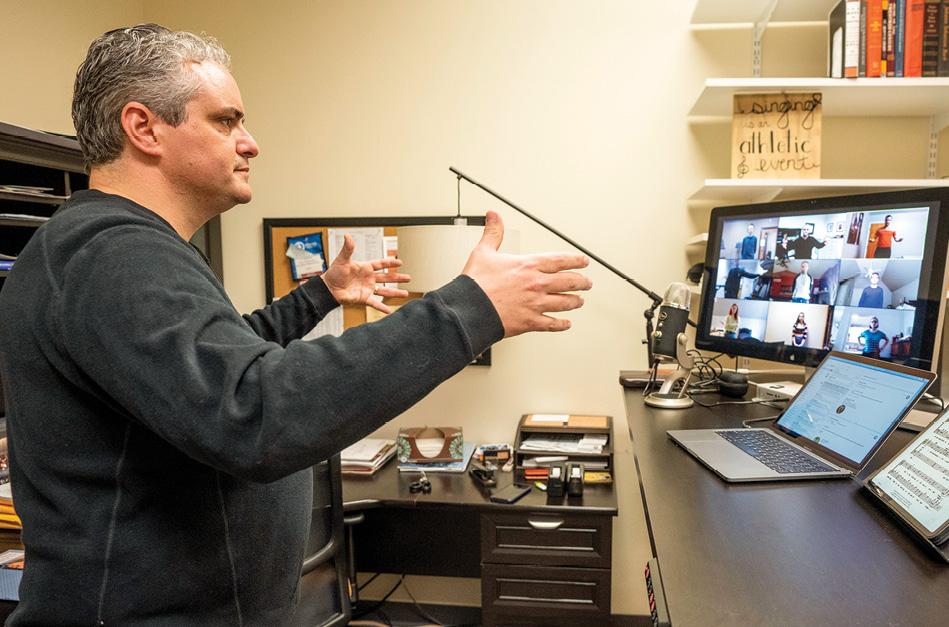
When the university announced it would be moving to online learning options starting March 16, Tucker Biddlecombe, associate professor of choral studies and choral director at the Blair School of Music, was among the first faculty members to embrace the possibility of teaching his students over a videoconferencing platform. His conducting class was quick to adapt to the challenges and possibilities that remote learning presented.
“There are a variety of challenges whenever you can no longer interface with your students,” says Biddlecombe. “However, there are also a couple of benefits. One of the things that was immediately evident was that students were not used to seeing themselves conducting. All of a sudden, they had a video feeding back to them immediately all the things that I usually tend to tell them. Their immediate ability to see themselves conducting [is something I want] to integrate permanently into what we’re doing.”
The Melodores, a student a cappella group, has used videoconferencing to continue making and sharing music during the COVID-19 crisis. The group’s recent video performances have been viewed more than 775,000 times on social media alone and have been featured on Good Morning America, ABC News, NBC News, and even in a recent campaign ad for presidential candidate Joe Biden.
“With approximately 20 performances lined up for the remainder of the semester, the decision to send everyone home was particularly devastating for the Melodores,” says senior Matt Zhang, the group’s musical director. “However, upon returning home, we quickly realized we didn’t need to be together physically to connect and hopefully spread some much-needed positivity through our music.”
Watch a video of Biddlecombe instructing his students virtually:
See the Melodores perform a Lizzo medley remotely:
ALUMNI STORIES OF RESILIENCE
Gov. Andy Beshear, BA’00, earns praise—and plenty of memes—for his handling of the pandemic

Kentucky Gov. Andy Beshear, who graduated from Vanderbilt in 2000 with a bachelor’s in anthropology, has emerged as one of the nation’s more popular leaders during the COVID-19 outbreak.
Beshear moved quickly to stem the spread of the disease in the state, declaring a public health emergency early in March—well ahead of many of his counterparts across the nation. And his daily COVID-19 news conferences, which have been characterized as modern-day versions of President Franklin Roosevelt’s fireside chats during the Great Depression and World War II, have endeared him not only to the state’s residents, but to many others nationwide.
“Gov. Beshear has started several recent briefings with his key message, ‘We will get through this; we will get through this together,’ … and then asked viewers at home to repeat it as well, as a kind of mantra for the whole state,” The Wall Street Journal reported in a story mentioning his popular chats.
Beshear’s fans have turned to the internet to show their appreciation for his steady handling of the crisis. Dozens of internet memes have appeared comparing him to heroes like Captain America, Superman and even Mister Rogers. In fact, one Facebook group—“Andy Beshear Memes for Social Distancing Teens”—now boasts more than 227,000 members.
As NPR’s Morning Edition reported March 25, “Kentuckians are loving Gov. Andy Beshear’s leadership on the COVID-19 crisis. The fandom has produced a deluge of memes and videos online that are helping the state cope with these uncertain times.”
Flip Biddelman, BS’09, converts Brooklyn eatery into soup kitchen
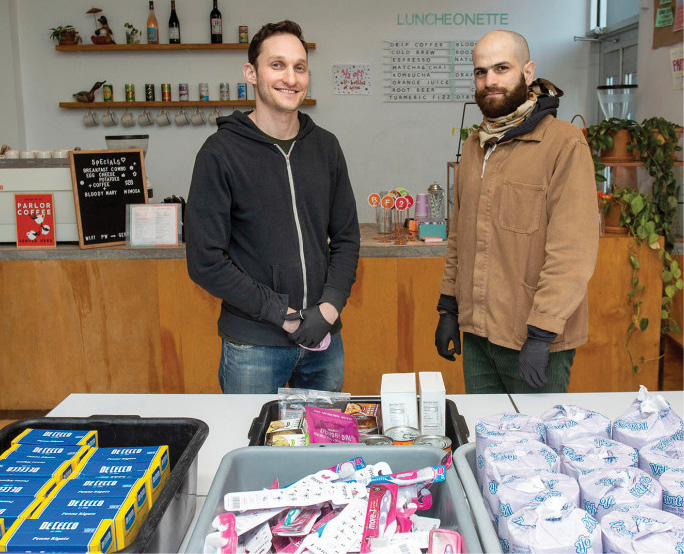
Restaurateur and alumnus Flip Biddelman and his business partner, Nate Adler, have converted their Brooklyn, New York, restaurant Gertie into a part-time soup kitchen for hospitality workers who have been laid off during the COVID-19 outbreak. The workers are invited four days a week for dinner and essentials, including coffee, pasta and even toilet paper.
A grant from celebrity chef Edward Lee’s Restaurant Relief Program has enabled the restaurant to provide workers 300 meals a day, and whatever goes uneaten is taken to a nearby medical center for hospital workers.
When the coronavirus outbreak forced restaurants in New York to shut down dine-in service, Biddelman and Adler had to fire nearly all their staff as they scraped by with takeout business. “That was one of the hardest things we had to do—to tell our staff that we don’t have any shifts for them and that they should file for unemployment,” Biddelman told The New York Post.
But since starting the soup kitchen, they have been able to hire back five kitchen workers and four front-of-house staffers—almost their entire team. “It has been such a relief,” Biddelman said.
Boll & Branch donates mattresses, pillows to hospitals
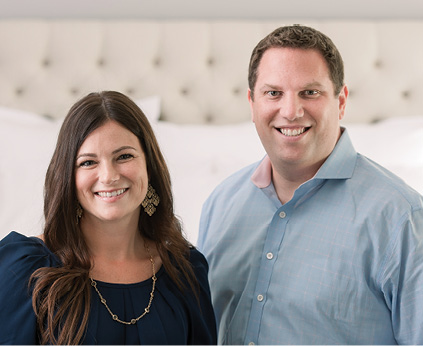
Missy Tannen, BS’99, and Scott Tannen, BS’99, co-founders of the textile company Boll & Branch, have announced a partnership with Sherwood Bedding and Downlite to manufacture 1,000 mattresses and 500 pillows, respectively, to donate to hospitals during the pandemic. Boll & Branch is among the companies recognized by New York Gov. Andrew Cuomo for their efforts to assist the state in its fight against COVID-19.
“The generosity of these companies, organizations and individuals—and many others coming forward every day to offer support—will play a critical role in our mission to bolster our hospital surge capacity, support frontline workers, and get people the help they need,” Cuomo said in a March 26 statement. “On behalf of the family of New York, I am deeply grateful for their generosity.”
Chris Mann, BMus’04, records coronavirus-inspired song parodies

Singer–songwriter Chris Mann, who recently played the Phantom in The Phantom of the Opera’s 25th anniversary tour, has unveiled numerous music video parodies inspired by the pandemic, bringing some much-needed humor to viewers stuck at home.
The parodies include “My Corona,” based on The Knack’s classic “My Sharona,” and “Hello (from the Inside),” a spoof of Adele’s chart-topper in which Mann proudly sports a Vanderbilt sweatshirt. The videos—which have racked up nearly 25 million views on the internet and earned him a mention in The Washington Post as one of the “‘Weird Al’ Yankovics of our social distancing era”—can be viewed at chrismannmusic.com.
French Hill, BS’79, named to pandemic aid watchdog panel

U.S. Rep. French Hill (R-Ark.), a former banker and deputy assistant treasury secretary, has been named House Republicans’ representative on the five-member Congressional Oversight Commission, created to supervise government spending on the COVID-19 pandemic. The watchdog group was created as part of the roughly $2 trillion relief package enacted by Congress in March.
“[Hill’s] personal background as a senior official at the Department of the Treasury and as a private banker provides important expertise that will guide his advocacy of immediate and effective solutions for the American people struggling from despair during this crisis,” said House Minority Leader Kevin McCarthy (R-Calif.), who had named Hill to the commission.